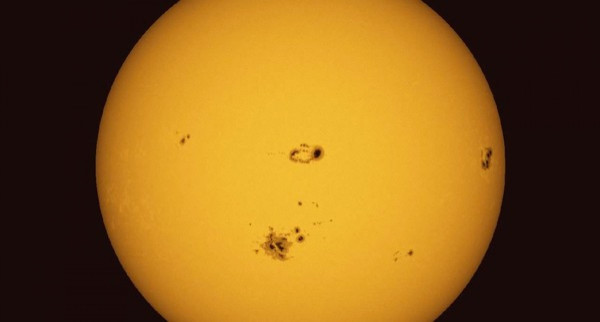Sunspots: Scientists Listen to the Sun to Provide Advanced Warning of Solar Eruption [VIDEO]

Researchers at Stanford University say listening to the sounds the sun makes can help predict sunspots in their early stages of development, giving as much as two days warning.
Sunspots develop in active solar regions of strong, concentrated magnetic fields and seem dark when they reach the surface of the sun. Eruptions of the intense magnetic flux leads to solar storms, but until now, no one was able to predict them.
But Stanford researchers developed a method that allows them to peer deep into the sun's interior, using acoustic waves to catch early stage sunspots and give prompt warnings. If disruptions such as solar flares and mass eruptions could be predicted, measures could be taken to protect vulnerable electronics before solar storms strike. They can wreak havoc on communication systems, air travel, power grids and satellites, as well as astronauts in space.
Many solar physicists tried different ways to predict when sunspots would appear, but with no success, said Phil Scherrer, a professor of physics, in a statement. The research was done in his lab.
The key to the new method is using acoustic waves generated inside the sun by the turbulent motion of plasma and gases in constant motion. In the near-surface region, small-scale convection cells, which are about the size of California, generate sound waves that travel to the interior of the sun and are refracted back to the surface.
The researchers got some assistance from the Michelson Doppler Imager aboard NASA's Solar and Heliospheric Observatory satellite, known as SOHO.
The craft spent some 15 years making detailed observations of the sound waves within the sun. It was superseded in 2010 with the launch of NASA's Solar Dynamics Observatory satellite, which carries the Helioseismic and Magnetic Imager, according to the university in news release.
Using the data generated by the two imagers, Stathis Ilonidis, a Stanford graduate student in physics and lead author of the paper on the research, was able to develop a way to reduce the electronic clutter in the data so he could accurately measure the solar sounds.
The research, published in the Aug. 19 edition of Science.
Researchers said the new method enabled Ilonidis to detect sunspots in the early stages of formation as deep as 65,000 kilometers inside the sun. One to two days later, the sunspots would appear on the surface.
The principles used to track and measure the acoustic waves traveling through the sun are comparable to measuring seismic waves on Earth, the release stated. The researchers measure the travel time of acoustic waves between widely separated points on the solar surface.
We know enough about the structure of the sun that we can predict the travel path and travel time of an acoustic wave as it propagates through the interior of the sun, said Junwei Zhao, a senior research scientist at Stanford's Hansen Experimental Physics Lab. Travel times get perturbed if there are magnetic fields located along the wave's travel path.
Those alarms are what tip the researchers that a sunspot is forming.
So by measuring and comparing millions of pairs of points and the travel times between them, the researchers are able to zero in on the anomalies that reveal the growing presence of magnetic flux related with an early sunspot.
The researchers found that sunspots that ultimately become large rise up to the surface quicker than those that stay small. The larger sunspots are the ones that spawn the biggest disruptions, and for those the warning time is roughly a day. The smaller ones can be found up to two days before they reach the surface, the release stated.
Researchers have suspected for a long time that sunspot regions are generated in the deep solar interior, but until now the emergence of these regions through the convection zone to the surface had gone undetected, Ilonidis said. We have now successfully detected them four times and tracked them moving upward at speeds between 1,000 and 2,000 kilometers per hour.
Stanford said one of the big goals with forecasting space weather is achieving a three-day warning time of impending solar storms. That would give the potential victims a day to plan, another day to put the plan into action and a third day as a safety margin.
Watch the video below:
© Copyright IBTimes 2025. All rights reserved.






















